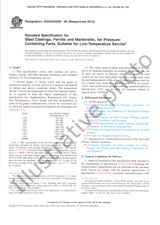We need your consent to use the individual data so that you can see information about your interests, among other things. Click "OK" to give your consent.
ASTM D6560-22
Standard Test Method for Determination of Asphaltenes (Heptane Insolubles) in Crude Petroleum and Petroleum Products
Translate name
STANDARD published on 1.6.2022
The information about the standard:
Designation standards: ASTM D6560-22
Publication date standards: 1.6.2022
SKU: NS-1068727
The number of pages: 6
Approximate weight : 18 g (0.04 lbs)
Country: American technical standard
Category: Technical standards ASTM
The category - similar standards:
Annotation of standard text ASTM D6560-22 :
Keywords:
asphaltenes, bitumen, crude petroleum, diesel fuel, gas oil, heptane insoluble residues, lubricating oil, residual fuel oils,, ICS Number Code 75.040 (Crude petroleum),75.080 (Petroleum products in general)
Additional information
| Significance and Use | ||||||||||||
|
5.1?Asphaltenes are the organic molecules of highest molecular mass and carbon-hydrogen ratio normally occurring in crude petroleum and petroleum products containing residual material. They may give problems during storage and handling if the suspension of asphaltene molecules is disturbed through excess stress or incompatibility. They are also the last molecules in a product to combust completely, and thus may be one indicator of black smoke propensity. Their composition normally includes a disproportionately high quantity of the sulfur, nitrogen, and metals present in the crude petroleum or petroleum product. |
||||||||||||
| 1. Scope | ||||||||||||
|
1.1?This test method covers a procedure for the determination of the heptane insoluble asphaltene content of gas oil, diesel fuel, residual fuel oils, lubricating oil, bitumen, and crude petroleum that has been topped to an oil temperature of 260 ?C (see A1.2.1.1). 1.2?The precision is applicable to values between 0.50 % m/m and 30.0 % m/m. Values outside this range may still be valid but may not give the same precision values. 1.3?Oils containing additives may give erroneous results. 1.4?The values stated in SI units are to be regarded as standard. No other units of measurement are included in this standard. 1.5?This standard does not purport to address all of the safety concerns, if any, associated with its use. It is the responsibility of the user of this standard to establish appropriate safety, health, and environmental practices and determine the applicability of regulatory limitations prior to use. 1.6?This international standard was developed in accordance with internationally recognized principles on standardization established in the Decision on Principles for the Development of International Standards, Guides and Recommendations issued by the World Trade Organization Technical Barriers to Trade (TBT) Committee. |
||||||||||||
| 2. Referenced Documents | ||||||||||||
|
We recommend:
Technical standards updating
Do you want to make sure you use only the valid technical standards?
We can offer you a solution which will provide you a monthly overview concerning the updating of standards which you use.
Would you like to know more? Look at this page.




 Cookies
Cookies
